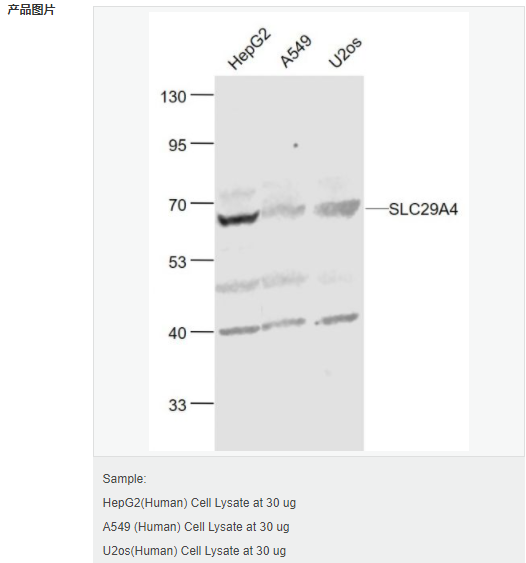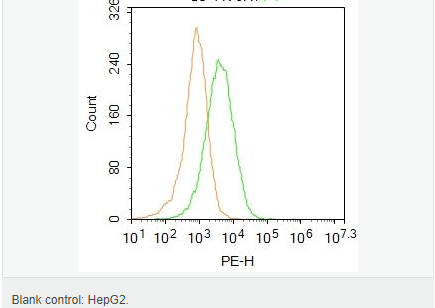

貨號
產(chǎn)品規格
售價(jià)
備注
BN41001R-100ul
100ul
¥2360.00
交叉反應:Human(predicted:Mouse,Rat,Dog,Pig,Cow,Rabbit) 推薦應用:WB,Flow-Cyt,ELISA
BN41001R-200ul
200ul
¥3490.00
交叉反應:Human(predicted:Mouse,Rat,Dog,Pig,Cow,Rabbit) 推薦應用:WB,Flow-Cyt,ELISA
產(chǎn)品描述
| 英文名稱(chēng) | SLC29A4 |
| 中文名稱(chēng) | 腦質(zhì)膜單胺轉運蛋白PMAT抗體 |
| 別 名 | Brain transport protein PMAT; ENT 4; ENT4; Equilibrative nucleoside transporter 4; FLJ34923; Plasma membrane monoamine transporter; PMAT; Solute carrier family 29 (nucleoside transporters) member 4; S29A4_HUMAN; Solute carrier family 29 member 4. |
| 研究領(lǐng)域 | 腫瘤 細胞生物 免疫學(xué) 神經(jīng)生物學(xué) 信號轉導 轉運蛋白 |
| 抗體來(lái)源 | Rabbit |
| 克隆類(lèi)型 | Polyclonal |
| 交叉反應 | Human, (predicted: Mouse, Rat, Dog, Pig, Cow, Rabbit, ) |
| 產(chǎn)品應用 | WB=1:500-2000 ELISA=1:5000-10000 Flow-Cyt=3ug/Test not yet tested in other applications. optimal dilutions/concentrations should be determined by the end user. |
| 分 子 量 | 58kDa |
| 細胞定位 | 細胞膜 |
| 性 狀 | Liquid |
| 濃 度 | 1mg/ml |
| 免 疫 原 | KLH conjugated synthetic peptide derived from human SLC29A4:401-500/530 |
| 亞 型 | IgG |
| 純化方法 | affinity purified by Protein A |
| 儲 存 液 | 0.01M TBS(pH7.4) with 1% BSA, 0.03% Proclin300 and 50% Glycerol. |
| 保存條件 | Shipped at 4℃. Store at -20 °C for one year. Avoid repeated freeze/thaw cycles. |
| PubMed | PubMed |
| 產(chǎn)品介紹 | This gene is a member of the SLC29 family and encodes a plasma membrane protein with 11 transmembrane helices. This protein catalyzes the reuptake of monoamines into presynaptic neurons, thus determining the intensity and duration of monoamine neural signaling. It has been shown to transport several compounds, including serotonin, dopamine, and the neurotoxin 1-methyl-4-phenylpyridinium. Alternate transcriptional splice variants which encode the same protein have been characterized. [provided by RefSeq, Jul 2008]. Function: Functions as a polyspecific organic cation transporter, efficiently transporting many organic cations such as monoamine neurotransmitters 1-methyl-4-phenylpyridinium and biogenic amines including serotonin, dopamine, norepinephrine and epinephrine. May play a role in regulating central nervous system homeostasis of monoamine neurotransmitters. May be involved in luminal transport of organic cations in the kidney and seems to use luminal proton gradient to drive organic cation reabsorption. Does not seem to transport nucleoside and nucleoside analogs such as uridine, cytidine, thymidine, adenosine, inosine, guanosine, and azidothymidine. In (PubMed:16873718) adenosine is efficiently transported but in a fashion highly sensitive to extracellular pH, with maximal activity in the pH range 5.5 to 6.5. Glu-206 is essential for the cation selectivity and may function as the charge sensor for cationic substrates. Transport is chloride and sodium-independent but appears to be sensitive to changes in membrane potential. Weakly inhibited by the classical inhibitors of equilibrative nucleoside transport, dipyridamole, dilazep, and nitrobenzylthioinosine. May play a role in the regulation of extracellular adenosine concentrations in cardiac tissues, in particular during ischemia. Subcellular Location: Cell membrane; Multi-pass membrane protein (Potential). Apical cell membrane; Multi-pass membrane protein (Potential). Note=Located to the plasma membranes of ventricular myocytes and vascular endothelial cells. Targeted to the apical membranes of differentiated kidney epithelial cells. Tissue Specificity: Expressed abundantly in the heart, in both cardiomyocytes and vascular endothelial cells (at protein level). Highly expressed in brain, kidney and skeletal muscle. In the brain expressed in cerebellum, cerebral cortex, medulla, occipital pole, frontal and temporal lobes putamen and in the spinal cord. Lower expression in liver, pancreas, and liver. Expressed in endometrial tissue, exclusively in the stroma. Expression is high in the proliferative phase, decreases during the secretory phase, and is no longer detectable in the menstrual phase. Post-translational modifications: N-glycosylated. Similarity: Belongs to the SLC29A transporter family. SWISS: Q7RTT9 Gene ID: 222962 Database links: Entrez Gene: 222962 Human Omim: 609149 Human SwissProt: Q7RTT9 Human Unigene: 4302 Human Important Note: This product as supplied is intended for research use only, not for use in human, therapeutic or diagnostic applications. |

